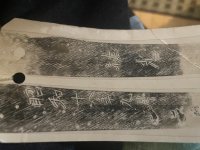I have dabbled a bit in Japanese swords, and own one, a wakizashi, or short sword. The advice to seek the counsel of your seller, a serious collector, is the best idea, I think. If he has maintained the sword, had it polished within the last couple of decades, you may well need to do nothing at all other than light maintenance with a cleaning kit every six months or so.
If the blade needs polishing, that's a whole other ball of wax.
My wakizashi was inherited from my father. It was a WWII bring back, and had some rust. It is also mid 19th century. Not made by a famous smith, but a good blade, I was told. I had it polished in Japan for about $1800 25 years ago. This was not particularly expensive, and was considered work suitable for the quality of my blade. A higher quality blade would have gone to a different polisher and cost more.
I question whether true Japanese sword polishers even exist in the US. I recall reading, when I was dabbling, years ago, that to become a sword smith takes ten years of apprenticeship. To become a sword polisher, which is a seperate profession, takes twelve.


